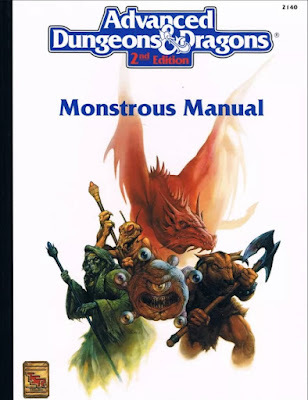Retrospective: Monstrous Manual
 In the course of writing posts about the pictorial histories of several standard Dungeons & Dragons monsters, I often consulted 1993's Monstrous Manual. This book, released four years after the launch of AD&D Second Edition was, according to its own introduction, "created in response to many requests to gather monsters into a single, durable volume which would be convenient to carry." The introduction goes on to say that, alongside the Player's Handbook and Dungeon Master's Guide, the Monstrous Manual "forms the core of the AD&D 2nd Edition game."
In the course of writing posts about the pictorial histories of several standard Dungeons & Dragons monsters, I often consulted 1993's Monstrous Manual. This book, released four years after the launch of AD&D Second Edition was, according to its own introduction, "created in response to many requests to gather monsters into a single, durable volume which would be convenient to carry." The introduction goes on to say that, alongside the Player's Handbook and Dungeon Master's Guide, the Monstrous Manual "forms the core of the AD&D 2nd Edition game."Those unfamiliar with the history of Second Edition can be forgiven for wondering why it took TSR four years to publish what is essentially an updated version of the venerable Monster Manual or why this version carries a slightly different title than its predecessor, unlike either the PHB or DMG, whose titles remained the same. The truth is that the Monstrous Manual was a do-over, TSR's attempt to fix the grave mistake of the Monstrous Compendium, released in 1989 along with the other 2e rulebooks. Rather than being a hardcover book, the Compendium was a D-ring binder designed to hold loose, three-hole punched sheets of monster entries. The Compendium was an interesting high concept, its actual implementation proved impractical o multiple levels, hence the need for the Monstrous Manual.
The Monstrous Manual is a very large book, larger than either of its companion 2e volumes or indeed of any AD&D rulebook published up to that point. At 384 pages, it includes all the contents of Volumes One and Two of the original Monstrous Compendium, along with additional monsters imported from the MC volumes associated with the Greyhawk, Forgotten Realms, Spelljammer, and Dark Sun settings. By necessity, many of these entries are abbreviated in length from their original Compendium appearances, since, with a handful of exceptions, all are limited to a single page. Even so, the book uses a small type face and all the entries are quite dense. Like the MC, each entry includes an illustration – this time in color – but, unlike its predecessor, these illustrations are largely provided by a new generation of artists rather than longtime TSR hands like Jeff Easley or James Holloway.
The presence of these new artists, most notably Tony DiTerlizzi, gives the Monstrous Compendium a very distinctive look, one that stands out from earlier 2e releases. I remember being struck by this even at the time I originally bought the book. DiTerlizzi, for example, is best known for his defining work on the Planescape setting, which didn't come out until a year later. His illustrations in the Monstrous Manual are uniformly excellent and admirable – but they nevertheless represent a strong break with AD&D's artistic past, which had broadly favored artwork with a more "traditional" high fantasy/sword-and-sorcery esthetic. DiTerlizzi's work meanwhile has an otherworldly, fairytale-ish quality that works better for some monsters than for others. Likewise, it contrasts with the comic book-inspired illustrations of Jeff Butler and the dark moodiness of Thomas Baxa, two other artists whose styles are quite different from those of TSR's past. The result is, by my lights, an artistic mishmash that detracts somewhat from its content.
And that content is, by and large, quite solid. The Monstrous Manual is good and useful, eminently more suited to its purpose than was the Monstrous Compendium, if for no other reason than it is practical. As I mentioned above (and in my earlier Retrospective post about it), the MC was an interesting high concept that might have worked had TSR thought a little more about the details of its design. There is nothing clever about the design of the Monstrous Manual, but it at least served its intended purpose without much fuss. That it also included a very large selection of monsters – far more than the original Monster Manual – was another point in its favor.
From the vantage point of more than three decades after its original publication, what strikes me most about the Monstrous Manual is how it reminds that TSR never had a clear plan of what to do with AD&D as a game line and, even when it did, it often bungled those plans. From its original conception under Gary Gygax to its eventual realization under David Cook, AD&D 2e was always conceived as a way to correct, regularize, and improve upon the foundations laid by First Edition. However, for various reasons, those plans never fully came to pass. Instead, we got missteps, half-measures, and course corrections that, in retrospect, casts a shadow even over the best products of 2e, like the Monstrous Manual.
James Maliszewski's Blog
- James Maliszewski's profile
- 3 followers



